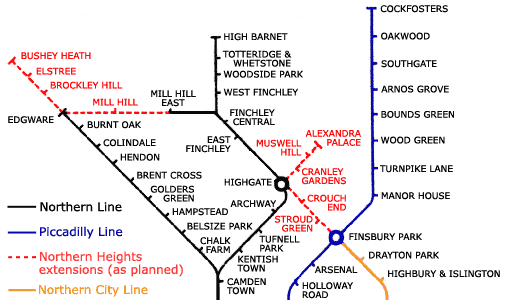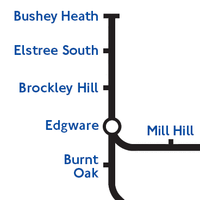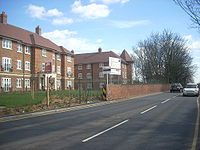_railway_station.gif)
Mill Hill (The Hale) railway station
Encyclopedia
Mill Hill railway station was a station in Mill Hill
, London
NW7 on the now-removed railway between Mill Hill East station
and Edgware railway station
. It was located near the junction of Bunns Lane and Lyndhurst Avenue.
and was opened on 22 August 1867 by the Great Northern Railway
(GNR) (which had taken over the EH&LR) in what was then rural Middlesex
. The station, then named The Hale Halt, was not opened until 1906, on the single track from Finchley Central to Edgware. The whole line ran from Finsbury Park
to Edgware
via Highgate with branches to Alexandra Palace
and High Barnet
.
After the 1921 Railways Act
created the Big Four railway companies, the line was, from 1923, part of the London & North Eastern Railway
(LNER). The station was named Mill Hill (The Hale) in 1928.
 In 1935 London Underground
In 1935 London Underground
devised a "New Works Programme" of improvements, and planned to take over the line from the LNER in its "Northern Heights" plan. The line was to be modernised for use by electric trains on double track, and amalgamated with the Northern Line
.
 Works began in the late 1930s and were at an advanced stage when they were interrupted by the Second World War. The section of line between Finchley Central station
Works began in the late 1930s and were at an advanced stage when they were interrupted by the Second World War. The section of line between Finchley Central station
and Edgware was closed to passenger services on 10 September 1939. On the Edgware branch of the line, only the works on the section from Finchley Central to Mill Hill East were completed, to allow access to and from the nearby army barracks. That section reopened with Underground services in 1941 as a one-station spur.
After the war a shortage of funds led to the cancellation of the Northern Heights work in the early 1950s. Mill Hill (The Hale) was the only station between Edgware and Mill Hill East and, as Edgware was already served by the Underground from its own station in the town and Mill Hill was served by the nearby London Midland and Scottish Railway (LMS) Mill Hill Broadway station
, there was little need for the completion of the track modernisation works and the reopening of the line for passenger services. The line continued to be used for goods until 29 February 1964 when it was completely closed.
 Until the early 1970s it was possible to buy an Underground ticket to "Mill Hill The Hale" even though no such station had existed for years. This enabled passengers to keep their tickets upon alighting at Mill Hill East and to travel onward by 240A bus anywhere between Mill Hill and Edgware.
Until the early 1970s it was possible to buy an Underground ticket to "Mill Hill The Hale" even though no such station had existed for years. This enabled passengers to keep their tickets upon alighting at Mill Hill East and to travel onward by 240A bus anywhere between Mill Hill and Edgware.
Today the track has been removed and the platforms and station buildings have been demolished. The site of Mill Hill (The Hale) station was covered by material excavated for the construction of slip roads to the nearby section of the M1 motorway
.
In 2007 work began to build flats on the site of the former station, but the bridge over the former tracks remains.
Former Services
Abandoned Works
Mill Hill
Mill Hill is a place in the London Borough of Barnet. It is a suburb situated 9 miles north west of Charing Cross. Mill Hill was in the historic county of Middlesex until it was absorbed by London...
, London
London
London is the capital city of :England and the :United Kingdom, the largest metropolitan area in the United Kingdom, and the largest urban zone in the European Union by most measures. Located on the River Thames, London has been a major settlement for two millennia, its history going back to its...
NW7 on the now-removed railway between Mill Hill East station
Mill Hill East tube station
Mill Hill East tube station is a London Underground station in Mill Hill in North London.The station is on the High Barnet branch of the Northern Line, and is the terminus, and only station, of a branch from Finchley Central station...
and Edgware railway station
Edgware railway station
Edgware railway station was a London and North Eastern Railway station in Station Road, Edgware, Greater London. It is not to be confused with the London Underground Northern line Edgware station approximately 200 metres to the north east.-History:...
. It was located near the junction of Bunns Lane and Lyndhurst Avenue.
History
The railway line was built by the Edgware, Highgate and London RailwayEdgware, Highgate and London Railway
The Edgware, Highgate and London Railway was a railway in north London. The railway was a precursor of parts of London Underground's Northern Line and was, in the 1930s the core of an ambitious expansion plan for that line which was thwarted by the Second World War...
and was opened on 22 August 1867 by the Great Northern Railway
Great Northern Railway (Great Britain)
The Great Northern Railway was a British railway company established by the Great Northern Railway Act of 1846. On 1 January 1923 the company lost its identity as a constituent of the newly formed London and North Eastern Railway....
(GNR) (which had taken over the EH&LR) in what was then rural Middlesex
Middlesex
Middlesex is one of the historic counties of England and the second smallest by area. The low-lying county contained the wealthy and politically independent City of London on its southern boundary and was dominated by it from a very early time...
. The station, then named The Hale Halt, was not opened until 1906, on the single track from Finchley Central to Edgware. The whole line ran from Finsbury Park
Finsbury Park station
Finsbury Park Station is a busy transport interchange in North London. The interchange consists of an interconnected National Rail station, London Underground station and two bus stations. The main entrances are by the eastern bus station on Station Place...
to Edgware
Edgware railway station
Edgware railway station was a London and North Eastern Railway station in Station Road, Edgware, Greater London. It is not to be confused with the London Underground Northern line Edgware station approximately 200 metres to the north east.-History:...
via Highgate with branches to Alexandra Palace
Alexandra Palace railway station (Muswell Hill branch)
Alexandra Palace railway station is a former station in the grounds of Alexandra Palace in the Muswell Hill area of north London...
and High Barnet
High Barnet tube station
High Barnet tube station is a London Underground station located in High Barnet in North London. The station is the terminus of the High Barnet branch of the Northern line and is in Travelcard Zone 5. It is the northernmost station on the Northern line and is situated 10.2 miles north north-west...
.
After the 1921 Railways Act
Railways Act 1921
The Railways Act 1921, also known as the Grouping Act, was an enactment by the British government of David Lloyd George intended to stem the losses being made by many of the country's 120 railway companies, move the railways away from internal competition, and to retain some of the benefits which...
created the Big Four railway companies, the line was, from 1923, part of the London & North Eastern Railway
London and North Eastern Railway
The London and North Eastern Railway was the second-largest of the "Big Four" railway companies created by the Railways Act 1921 in Britain...
(LNER). The station was named Mill Hill (The Hale) in 1928.

London Underground
The London Underground is a rapid transit system serving a large part of Greater London and some parts of Buckinghamshire, Hertfordshire and Essex in England...
devised a "New Works Programme" of improvements, and planned to take over the line from the LNER in its "Northern Heights" plan. The line was to be modernised for use by electric trains on double track, and amalgamated with the Northern Line
Northern Line
The Northern line is a London Underground line. It is coloured black on the Tube map.For most of its length it is a deep-level tube line. The line carries 206,734,000 passengers per year. This is the highest number of any line on the London Underground system, but the Northern line is unique in...
.

Finchley Central tube station
Finchley Central tube station is a London Underground station in the Church End area of Finchley, North London.The station is on the High Barnet branch of the Northern line, between West Finchley and East Finchley stations and is the junction for the short branch to Mill Hill East station...
and Edgware was closed to passenger services on 10 September 1939. On the Edgware branch of the line, only the works on the section from Finchley Central to Mill Hill East were completed, to allow access to and from the nearby army barracks. That section reopened with Underground services in 1941 as a one-station spur.
After the war a shortage of funds led to the cancellation of the Northern Heights work in the early 1950s. Mill Hill (The Hale) was the only station between Edgware and Mill Hill East and, as Edgware was already served by the Underground from its own station in the town and Mill Hill was served by the nearby London Midland and Scottish Railway (LMS) Mill Hill Broadway station
Mill Hill Broadway railway station
Mill Hill Broadway railway station is in the London Borough of Barnet in North London.The station lies on the Midland Main Line and is served by First Capital Connect trains as part of the Thameslink Line service. It is in Travelcard Zone 4...
, there was little need for the completion of the track modernisation works and the reopening of the line for passenger services. The line continued to be used for goods until 29 February 1964 when it was completely closed.

Today the track has been removed and the platforms and station buildings have been demolished. The site of Mill Hill (The Hale) station was covered by material excavated for the construction of slip roads to the nearby section of the M1 motorway
M1 motorway
The M1 is a north–south motorway in England primarily connecting London to Leeds, where it joins the A1 near Aberford. While the M1 is considered to be the first inter-urban motorway to be completed in the United Kingdom, the first road to be built to motorway standard in the country was the...
.
In 2007 work began to build flats on the site of the former station, but the bridge over the former tracks remains.

